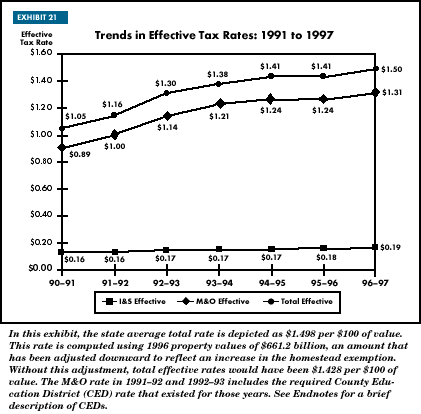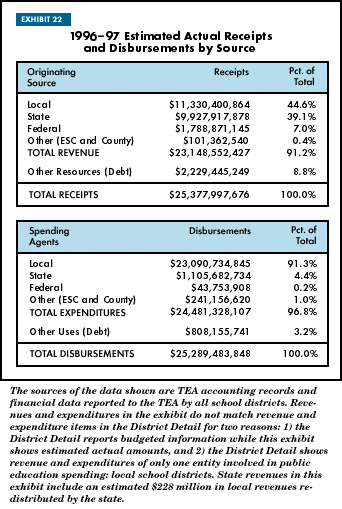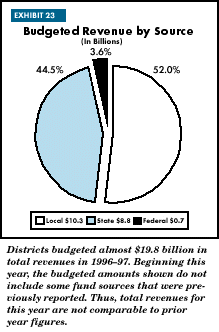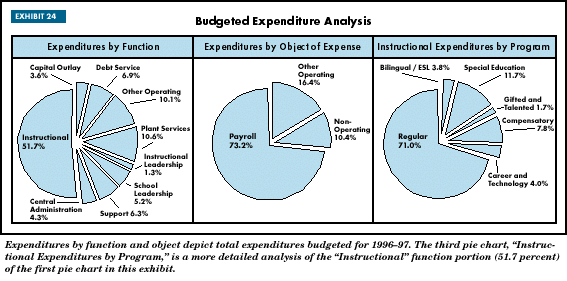
|
Funding for public education in Texas comes from three major sources: local, state, and federal. Local funding is derived from taxes on district property value. State funding is based on legislative appropriations determined through a finance system defined in statute. Federal funds are appropriated by Congress, generally for specific purposes. State FundsState funds for public education in Texas are distributed through a system of formulas known as the Foundation School Program (FSP). Not surprisingly, given the variation in other aspects of Texas public education, there is significant variation in the ability of local districts to raise local funds to finance education costs. A multi-decade history of litigation has addressed the appropriate state response to this disparity. In reply to the Edgewood v. Kirby litigation filed in 1984, a series of legislative actions to establish a constitutional method for funding Texas public schools evolved. Legal challenges to these solutions--Senate Bill 1019 in 1989, Senate Bill 1 in 1990, Senate Bill 351 in 1991, and Senate Bill 7 in 1993--all resulted in some form of redistribution of public funds for education. Only the last, Senate Bill 7, was declared constitutional by the Texas Supreme Court. The finance system in place in 1996-97 was based on this statute. The FSP uses statutory formulas to determine education costs for each district. The financing of these costs is shared between the state and the local district. A two-tiered system of formulas determines how state funds for public education are to be distributed. Under Senate Bill 7, as in prior legislation, the distribution of state aid to school districts is governed by two basic components; tier 1 state aid, and the guaranteed yield program, also known as tier 2. A district's wealth is a key component of the state's financing system because it is a measure of a district's potential to generate revenue locally. Wealth is defined as the district's taxable property value per student. Tier 1 The first tier of the FSP is a financing system comprised of a series of allotments designed to ensure that each school district can provide instructional programs suitable to meet the basic educational needs of its students. For the 1996-97 school year, the basic allotment was $2,387 for each student in ADA. The basic allotment is adjusted by a cost of education index designed to reflect geographic variations in resource costs across the state that are beyond the control of local school districts. The basic allotment may be further increased by a small district or mid-sized district adjustment. A district receives supplemental funding over and above the adjusted basic allotment for serving students in special instructional programs such as bilingual education, career and technology, and gifted/talented education. Special education and compensatory education allotments are also provided. Allotments are calculated using various student counts. These include average daily attendance (ADA) and full-time equivalent (FTE) student counts. In some cases pupil counts are weighted by factors measuring the characteristics of the students. The result of the tier 1 computations is a figure for each district that represents the cost of providing the basic educational services for the students of that district. A fundamental tenet of the financing system is that the state and the school districts will share the cost of this tier. The share for each depends on the property tax base (wealth) of the school district. The wealthier the district, the greater the proportion of the cost that will be the responsibility of the district. Conversely, the poorer the district, the greater the state share. Beginning in 1993-94, districts wishing to participate in the FSP were required to levy a property tax of $0.86 per $100 of valuation as their share of tier 1. Typically, the wealthiest districts are not eligible for any tier 1 state aid, since $0.86 per $100 of their property value can usually generate an amount greater than their total cost of tier 1. In these instances, financing the total cost of tier 1 is a local responsibility. Tier 2 The guaranteed yield program, begun in 1989-90, provides additional funds to enrich the basic tier 1 program. This level of financing, often called tier 2, enables districts with wealth below $210,000 to earn additional state aid by setting their tax rate above the $0.86 minimum level needed for the first tier of the FSP. This program attempts to equalize state and local revenues between the poorest and wealthiest districts. For each penny of tax effort the district levies above the first tier requirement, within a calculated range that may not exceed an additional $0.64, the state will guarantee a yield of $21.00 per penny, per weighted student. The number of pennies for which the state guarantees the $21.00 yield for each year of the biennium is limited to the tax effort each district demonstrated in the second year of the preceding biennium. For example, if a district demonstrated a tax effort of $1.00 in the second year of the preceding biennium, the state would guarantee for each year of the next biennium a yield of $21.00 multiplied by 14 (the difference between $1.00 and $0.86), or $294 per weighted student. For the 1996-97 school year, the tax effort demonstrated in 1994-95 was used to determine this limit. The maximum guaranteed yield amount for 1996-97 was $1,344 per weighted student, which is based on the maximum tax effort allowed above the first tier requirement (an additional 64 cents multiplied by the $21.00 yield.) The state's share of tier 1 and tier 2 is financed by the General Revenue Fund and by the per capita apportionment from the Available School Fund (ASF). Constitutionally created in 1876, the ASF consists primarily of earnings from the Permanent School Fund and taxes dedicated to the fund by the state constitution. In 1996-97, the average amount of state aid for each student in ADA was $2,251. The per capita ASF apportionment was $331 per student in ADA, leaving the remaining $1,920 per student to be paid from General Revenue. All districts, irrespective of property wealth, receive the $331 ASF per capita amount for each student in average daily attendance. Exhibit 20 below, depicts the inverse relationship between district wealth and state funding. In both the basic allotment (tier 1) and guaranteed yield tier (tier 2) of the FSP, poorer districts receive a larger percentage of their revenue from the state while wealthier districts fund their operations with a greater percentage of local funds.
Exhibit 20 further illustrates the relationship between wealth and state aid by highlighting the fact that the local effort of the wealthiest group of districts generates as much revenue as the combined state, local, and federal amounts of the poorer groups. However, the variance among revenue per pupil for the remaining 90 percent of districts is minimized because of the FSP structure. Equalizing WealthThe current financing system establishes an equalized wealth level and requires districts above this level to reduce their wealth by choosing at least one of five options. In 1996-97, the statutory equalized wealth level was $280,000 per weighted pupil. The five wealth-reducing options from which districts may choose are defined in statute. They are: 1) Voluntary Consolidation. The boards of trustees of two or more districts agree to consolidate. The resulting consolidated district must have wealth less than the equalized wealth cap of $280,000 per weighted pupil. No districts selected this option in 1996-97. 2) Voluntary Detachment and Annexation of Property. The boards of trustees of two districts agree to detach property from one district and annex it to the other. The resulting wealth of the district detaching property cannot exceed $280,000 per weighted pupil and the resulting wealth of the district to which the property is annexed cannot exceed $210,000 per weighted student. No districts selected this option in 1996-97. 3) Purchase of Attendance Credits from the State. A district purchases attendance credits to reduce its wealth to the equalized wealth level. Each credit corresponds to one student in weighted average daily attendance (ADA) which is added to the district's own weighted ADA total for the purpose of calculating wealth. The cost of a credit is the greater of either the district's total tax revenue per weighted ADA or the state average total tax revenue per weighted ADA for the preceding school year. Money from the payment of credits is deposited for use in financing the FSP. Seventy districts chose this option in 1996-97. 4) Education of Students in Other Districts. To reduce its wealth to the equalized level, a district agrees to pay to educate students of another district. The students whose education is paid for are counted for purposes of computing the paying district's wealth per weighted student. The cost of educating each additional student is equal to the cost of attendance credits described in option three. Twenty districts chose this option in 1996-97. 5) Tax Base Consolidation. The boards of trustees of two or more districts agree to conduct an election to create a consolidated taxing district. Under this type of tax base consolidation all maintenance and operations (M&O) taxing authority resides in the taxing district. Component districts have no M&O taxing authority. No districts chose this option in 1996-97. If no option is exercised, the commissioner of education is directed to detach property and/or consolidate districts to achieve the equalized wealth level. Local FundsLocal funds for public education are raised primarily through the local property tax. Taxes are levied against locally assessed property rolls to generate revenue. All tax rates shown in this publication are effective, or standardized, tax rates. Effective rates are based on property values that are certified by the state Comptroller's Property Tax Division (CPTD). The comptroller's value for the taxable property of any given district may be higher than, lower than, or the same as that district's locally appraised value. The benefit of the comptroller's values is that all property has been assessed through a uniform system. Locally adopted tax rates, the rates most familiar to taxpayers, are not comparable to one another because they do not control for variation in local appraisal practices and optional exemptions. Districts may set two tax rates each year, one for maintenance and operations (M&O) and, if necessary, another for servicing debt, called the interest and sinking fund rate (I&S). Changes were made affecting tax rate limitations during the 1995 legislative session. Under provisions of House Bill 2610, locally adopted M&O tax rates are generally subject to a statutory maximum of $1.50 per $100 assessed valuation for 1996-97. Under current statute, a district is allowed to set a tax rate that will generate the same amount of levy for maintenance and operations as was generated the prior year. That rate, plus $0.08, becomes the district's rollback tax rate. If a district sets a tax rate above the rollback rate, an election is automatically triggered and the voters decide whether to limit the adopted rate to the rollback rate. The property values shown in this publication are for the 1996 calendar year. For this year, certified taxable property values for the state totaled $661.2 billion, only $0.66 billion (0.1 percent) greater than they were in calendar year 1995. Property values increased only slightly because of the constitutional amendment that increased the homestead exemption. Without the application of this increased exemption to the 1996 values, total property values for the state would have been $693.1 billion. Effective tax rates are computed by dividing the money collected from taxation (levies) by the standardized property values. Use of the certified 1996 values that were adjusted downward to reflect the increased homestead exemption, results in the total effective rate of $1.498 in Exhibit 21 below. Had the unadjusted $693.1 billion of property value been used, the state average total effective tax rate would have been $1.428 per $100 of value. All effective tax rates in this publication, including item 62 in the District Detail, are based on 1996 property values adjusted downward for the increased homestead exemption.
Federal FundsAlmost all federal funds are appropriated by Congress for specific programs or specific populations of students, and must be expended for designated purposes. The majority of these federal funds must be spent to supplement programs already in place, not to relieve the state of its financial obligation to provide programs that address the needs of special students. Often, the federal appropriations permit both local and state use of each state's allocation. The portion of the state's allocation to be spent by local school districts is distributed by formula. The remaining allocation is discretionary and may be spent at either the state or local level. Examples of federal sources of funding to school districts are the National School Lunch Program, various special education funds, and the Improving America's Schools Act, Title I Program for low-income students. Accounting for the SystemTexas public school districts use a uniform accounting system to record revenues and expenditures. Other entities, such as regional education service centers and county, state, and federal governments also receive and spend funds on behalf of public education in Texas. School district revenues, in combination with the revenues of these other entities, are referred to as total receipts. All expenditures made by local school districts, plus the additional expenditures made by all other entities for public education are referred to as total disbursements. School district financial data reported in this publication are budgeted amounts, not actual revenues and expenditures. Actual financial data for 1996-97 are not available at the time of publication. The financial information presented in this edition of Snapshot differs significantly from previous years due to several events which affected how budgeted expenditures and revenues are reported. First, the uniform accounting system used by districts to record revenues and expenditures changed beginning with the 1996-97 school year. Districts now follow the coding structure described in the Financial Accountability Resource Guide which differs significantly from the previous coding structure used. Second, the advent of open-enrollment charters presents a special challenge to data comparability between charters and all other districts. The chart of accounts used by charters is different from that followed by school districts in the Resource Guide. Care should be taken when comparing the financial data for an open-enrollment charter to other districts. Third, amounts budgeted in certain fund categories which were previously collected by the TEA are no longer collected. These are the Special Revenue Funds (including Shared Services Arrangements) and the Capital Projects Funds. This means the total reported budget is smaller than in previous years, which affects any comparisons made to prior year Snapshot financial data. Finally, an allocation process was applied by the TEA to each district's submitted information in order to convert certain financial information from generic codes to specific campus and program codes. ReceiptsThe major sources of revenue for public education are the state appropriations to the FSP and the tax revenue generated at the local level by districts. Exhibit 22 below, shows all receipts collected and all disbursements made on behalf of public education, by their source. Receipts equal total revenue from all sources plus other resources; disbursements equal total expenditures by all spending entities plus other uses. Other resources and other uses are related to local debt obligations.
Local revenue, $11.3 billion, represents only those funds received directly by school districts. State revenue, $9.9 billion, includes FSP funding and other items such as textbook purchases and state-matching contributions to the Teacher Retirement System. Beginning with 1993-94, state revenue also includes revenues collected from districts exercising one of the wealth equalizing options. For 1996-97, $228 million was collected through this feature of the FSP. These local tax dollars were redistributed as state aid. Additional revenue sources shown in the exhibit include federal funds and county and education service center contributions. Other resources are composed of the local issuance of debt and income from the sale of assets. Overall, total receipts in 1996-97 increased to $25.4 billion, 7.9 percent more than in 1995-96. District RevenuesTotal revenue from all sources (local, state, federal, and other) totaled $23.1 billion in 1996-97. Of this, $19.8 billion was budgeted by local school districts. The difference between district budgeted revenues and total revenue from all sources is $3.3 billion. A portion of this difference can be attributed to revenues for items such as textbook purchases and state-matching contributions to the Teacher Retirement System which are not budgeted by local districts. Also, districts no longer budget amounts in the Special Revenue Funds, yet these funds are included in the $23.1 billion total revenue figure. Another significant portion of the difference is due to the fact that districts historically under-budget the revenues they actually receive. Exhibit 23 below, shows district budgeted revenues by source. Local funds comprise 52 percent of total revenues in 1996-97. The vast majority of these local funds, 91.3 percent, are from local property taxes. In any district, the composition and level of revenue sources may vary substantially from the state average depending upon local wealth and qualifications for federal assistance.
DisbursementsAs shown in Exhibit 22, 91.3 percent of the disbursements for public school education are made by local school districts. The remaining 8.7 percent are expended directly from other governmental entities such as state, county and federal governments, and ESCs. Examples of state disbursements include expenditures for textbooks, state-administered schools, the Teacher Retirement System, and the TEA. District ExpendituresExpenditures are recorded by fund, function, object, and in some cases, by program. Functions describe the broad purposes of expenditures, such as instruction or administration. Object classifications describe the service or item purchased, for example payroll or supplies and materials. Program classifications are used to identify instructional areas or arrangements, such as the regular, special, career and technology, and bilingual education programs. Exhibit 24 below, shows the distribution of various expenditure categories by function, object, and program. In 1996-97, budgeted expenditures totaled $20.2 billion or $5,282 per pupil.
ExclusionsSome amounts are excluded from the figures in this document to provide a more equalized financial picture. If these amounts were not omitted, the comparison of one district to another would be distorted or amounts would be double-counted. Statewide, the total excluded for tuition transfers, wealth equalization transfers, and payments to shared services arrangements was approximately $449 million in 1996-97. Discussion of each type of exclusion follows. Tuition Transfers Small districts that do not offer all grades may obtain instructional services from another district for those grade levels. Because the transferring district does not count the enrollment of transferred students, including the expenditure distorts per pupil amounts. Payments made to other school districts under the Public Education Grant program are also excluded under this category. Statewide, $6.4 million was budgeted in these categories. Wealth Equalization TransfersWealth Equalization Transfers refer to the amounts budgeted by districts for the cost of reducing their property wealth to the required equalized wealth level. In 1996-97, 90 districts were required to exercise one of the options to reduce their wealth to the equalized level. The expenditures for districts which must transfer amounts to the state for redistribution are not shown, as that would duplicate accounting for these dollars. Statewide, $387.7 million was budgeted in this category in 1996-97. Payments to Shared Services ArrangementsSome districts participate in shared services arrangements (SSAs, previously termed "cooperatives") with other districts. The fiscal agent or manager of the SSA may be another district, an ESC, or a county. One of the most common types of SSA is one where special education services are shared among member districts. An indicator is shown in the District Detail for each district that participates in, or is a fiscal agent of, a special education SSA. These districts may have per pupil expenditure amounts that differ from expectations because students served by the fiscal agent or member district are not necessarily enrolled in the district providing the services. To correct for this, any amounts budgeted in this category have been excluded. Budgeted expenditures reported in this category were $54.9 million in 1996-97. Funds ExcludedIn addition to the exclusions cited above, there is a portion of the financial picture for school districts that cannot be provided in Snapshot. This is because, beginning with 1996-97, districts are not required to report budgeted amounts for two types of funds: the Special Revenue Funds and the Capital Projects Funds. The omission of the Special Revenues Funds represents a significant change from prior years. The Special Revenues Funds (codes 200, 300, and 400) are program money from various federal and state sources. Two factors mitigate the loss of information about these funds. One is that the National School Lunch Funds, which are part of the 200 code series, are still reported and included. Secondly, Shared Services Arrangements Funds, which are now part of the 300 series, were purposely excluded from previous editions of Snapshot, so losing them represents no change over previous practice. Actual expenditures from the prior year provide an approximation of the impact of the loss of these Special Revenue Funds on current year budgets. In 1995-96, actual expenditures for Special Revenue Funds were $1.1 billion. Excluding the National School Lunch amounts, this represented 5.8 percent of 1995-96 total expenditures. Capital Projects Funds were purposely excluded from previous Snapshot publications to enhance comparability among districts with and without building programs. This omission of Capital Projects Funds represents no change over previous editions. Financial resources committed to capital projects and facilities, though not shown at the district level, can be summarized for the state. In response to increasing enrollments, school districts have consistently increased indebtedness to expand facilities, and as a result, debt service payments have risen. For the 1995-96 school year, the most recent year for which actual data are available, total school district debt was estimated to be $11.8 billion, compared to $6.5 billion in 1986-87. In 1996-97, school districts planned to spend approximately $1.4 billion to meet their debt service obligations for principal and interest, and anticipated collecting $1.2 billion in debt service tax revenues. The $1.4 billion budgeted for debt service payments represents 6.9 percent of all school district budgeted expenditures. More than 61 percent of all school districts have debt service payments. Among these districts, the average effective debt service tax rate is $0.21 per $100 of property value. Districts with the highest debt service tax rates are among the poorest in property value per pupil. |
Text & Exhibits | Snapshot '97 | Snapshot | Performance Reporting | TEA Home Page




